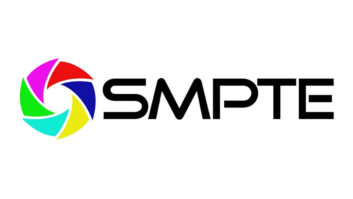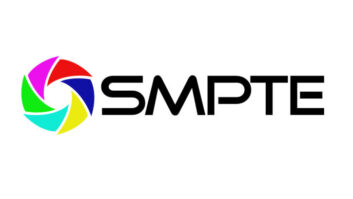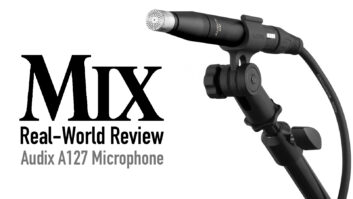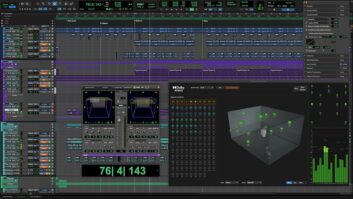SMPTE Standard 202 Work Group members setting up the microphone tree near the screen and the measurement microphones at the mixing console and producer’s desk in one of a large studio’s dubbing theaters

You may or may not be familiar with the Society of Motion Picture and Television Engineers (SMPTE) organization. If you’ve gone to the movies lately or watched TV, you most certainly have heard the results of their work!
Audix is pleased to provide TM1 omni-directional test and measurement microphones to help update SMPTE Standard 202, B-Chain electro-acoustic response, for the measurement and calibration of sound mixing and playback for cinema; from the dubbing rooms where the mix is created to theaters showing the latest blockbuster movies.
The 202 Standard lays out the ground rules and procedures for evaluating and calibrating a film ‘dubbing’ room where sound is mixed, to the theater where the movie is played. It starts by specifying the performance requirements of every component involved in measuring these rooms and calibrating the entire process of audio mixing and playback; assuring that what the cinema sound team creates is what you hear from Row D, seat 12. Oh, and in 5.1 or 7.1 surround!
A SMPTE Work Group member highlighting one of the measurement microphones in a film studio’s dubbing control room

Starting in 2009, the SMPTE 202 Work Group set out to update the standard using the latest tools available; updating a standard that was created long before the availability of high-powered portable computers and DSP-based analysis programs. SMPTE members Neil Shaw – Menlo Scientific Acoustics, Inc., and David Revel – TechMD, Inc., both members of the 202 Work Group, explain the details:
“Our goal is to get the presentation theaters audio playback to match as closely as possible the audio in the film dubbing stage where the soundtrack audio is mixed,” explains Revel. “We need to be sure that both ends of the process are measured and calibrated to the same exacting standard with a comparable set of tools so that we know that the mixes translate correctly.”
“At this stage of the 202 Standard reviews, we’re not evaluating the rooms themselves,” continues Revel. “We’re first evaluating the tools and practices to do so, and to establish a reliable process.”
The Audix TM1 measurement microphones at the mixing console and observer chair positions in one of an independent studio’s dubbing theaters
“Our tool-set includes calibration-grade microphones, multi-channel preamps and dual-FFT computer-based measurement systems,” explains Shaw. “To be clear, this is not a shoot-out of any particular tool in the set, rather an investigation of each tool type to establish an acceptable ‘envelope of performance.’ And it turns out that one of the greatest variables in this tool-set is the calibration microphone.”

A small selection of candidate microphones was selected; starting with the basic criterion of having a 1/4″ diameter diaphragm and 20 Hz – 20 kHz frequency response,” explains Shaw. “With a larger diaphragm significant differences from the actual sound pressure are introduced into the measurements at higher frequencies. We found a few models from several manufacturers that nicely fit the specification.”
The SMPTE process of evaluating just the calibration microphones alone is a painstaking task. “We use construction lasers to establish a perfectly flat plane around the room,” continues Shaw. “We then shoot a second vertically aligned laser to locate each test microphone on a three-dimensional grid within the room. And we do this for each test position of a 5.1 or 7.1 system.”
Neil Shaw (far left) along with Work Group members running AFMG/Renkus-Heinz’ EASERA SysTune, Rational Acoustics’ Smaart and Avid’s Pro Tools in a large commercial cinema.

“A positional error of a laser beams width in the microphone location can cause a phase-flop of 180 degrees resulting in a frequency response difference of plus or minus 6 dB at 10 KHz. That’s big!” adds Revel. “When evaluating a measurement microphone, these tolerances are critical in order to be able to attribute any performance variables to the microphone capsule itself, not our process.”
“The measurement process includes using a microphone calibrator, in this case a Bruel & Kjaer 4931 fitted with the Audix TM-1 4231 calibration adapter, to calibrate the B-chain system and then the Hollywood Edge Pink Noise loop for a constant frequency/ energy source to make the actual measurements,” continues Shaw. “In addition to our own live measurements, we also capture all data into an equally calibrated Pro Tools rig for later analysis. We also try to squeeze in enough time to play back some actual cinema audio content!”
Though SMPTE does not endorse specific products, the Audix TM1 met the standards of microphone performance and did very well against the ‘Gold Standards’ for calibration mics – finishing in the top two – at a significantly lower price. “The cost savings for people doing this professionally is considerable,” says Shaw.” To calibrate a 5.1 or 7.1 room, the laboratory grade microphone rig alone could exceed $25,000.”
Audix TM1 measurement microphones set up at audience positions in a theater for room measurement.

“It’s one thing to expect theater calibration experts in major markets to be able to invest in very expensive calibration tools,” adds Revel. “In order to serve secondary and smaller markets with the same level of results, a lower cost microphone solution that meets the performance requirements of this standard is ideal.”
“The Audix TM1 is an excellent choice,” says Shaw. “I do a lot of work with SysTune®, commissioning and tuning speaker systems, and I now pack the Audix TM1 calibration microphones when I’m on the road. They’re more than sufficient and accurate for this type of work.”
“Many manufacturers offer microphones that look like they are calibration-quality,” states Audix VP Cliff Castle. “TM1 is a proprietary design and we are proud that it is machined, assembled and tested by Audix in the USA. Our goal in designing the TM1 was to provide a measurement microphone capable of delivering SMPTE level performance for anyone tasked with such a technically critical process.”
Checking test results at a major loudspeaker manufacturers’ screening room, on a variety of platforms, are SMPTE 202 Work Group participants Brian Long of Skywalker Sound (standing), Bruce Olson of AFMG using SysTune, David Revel of TechMD on Smaart, Andy Potvin of Dolby Labs using AT5 and Tim Holmes of AcoustX on R2.
Founded in 1916, SMPTE has established over 400 standards for production practices and metrics. A lot has changed in the process of film production in nearly 100 years of SMPTE’s existence, so it’s inevitable that standards be reviewed and re-written from time to time to accommodate advances in technology. New tools emerge and new guidelines must be established for their use.

Both Neil Shaw – Menlo Scientific Acoustics, Inc. and David Revel – TechMD, Inc. have extensive resumes that include some of the most iconic performance venues in the world. You can learn more at:







